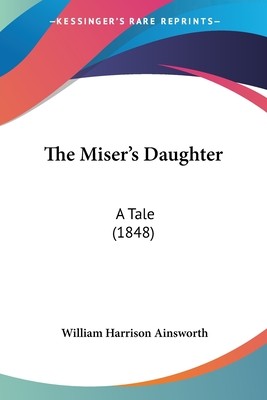
- We will send in 10–14 business days.
- Author: William Harrison Ainsworth
- Publisher: Kessinger Publishing
- ISBN-10: 0548793859
- ISBN-13: 9780548793855
- Format: 15.2 x 22.9 x 2.6 cm, minkšti viršeliai
- Language: English
- SAVE -10% with code: EXTRA
Reviews
Description
This novel is a historical romance that describes a young man pursuing the daughter of a miserly rich man during the 18th century.
Ainsworth wrote this novel in 1842 while he was writing Windsor Castle. During this time, he was constantly working and stopped only when his mother, Ann Ainsworth, died on 15 March 1842. It was published in a serialised form in the Ainsworth's Magazine with some overlap with Windsor Castle. George Cruikshank served as illustrator. The work was later published in novel format, but it did not include all of the illustrations used in the magazine. A play version was put on by Edward Stirling at Adelphia in October 1842. Another version was produced by T. P. Taylor in November 1842 at the City of London Theatre. In April 1872, a version of The Miser's Daughter called Hilda was produced for the Adelphi Theatre by Andrew Halliday. This prompted Cruikshank, on 6 April 1872, to write a letter to The Times about the theatrical production. In the letter, Cruikshank was upset that his name was left out of credits for the play and claimed that the idea for the novel came from himself and not from Ainsworth. This provoked a controversy between the two.
William Harrison Ainsworth (4 February 1805 - 3 January 1882) was an English historical novelist born at King Street in Manchester. He trained as a lawyer, but the legal profession held no attraction for him. While completing his legal studies in London he met the publisher John Ebers, at that time manager of the King's Theatre, Haymarket. Ebers introduced Ainsworth to literary and dramatic circles, and to his daughter, who became Ainsworth's wife. Ainsworth briefly tried the publishing business, but soon gave it up and devoted himself to journalism and literature. His first success as a writer came with Rookwood in 1834, which features Dick Turpin as its leading character. A stream of 39 novels followed, the last of which appeared in 1881. Ainsworth died in Reigate on 3 January 1882.
EXTRA 10 % discount with code: EXTRA
The promotion ends in 22d.03:23:01
The discount code is valid when purchasing from 10 €. Discounts do not stack.
- Author: William Harrison Ainsworth
- Publisher: Kessinger Publishing
- ISBN-10: 0548793859
- ISBN-13: 9780548793855
- Format: 15.2 x 22.9 x 2.6 cm, minkšti viršeliai
- Language: English English
This novel is a historical romance that describes a young man pursuing the daughter of a miserly rich man during the 18th century.
Ainsworth wrote this novel in 1842 while he was writing Windsor Castle. During this time, he was constantly working and stopped only when his mother, Ann Ainsworth, died on 15 March 1842. It was published in a serialised form in the Ainsworth's Magazine with some overlap with Windsor Castle. George Cruikshank served as illustrator. The work was later published in novel format, but it did not include all of the illustrations used in the magazine. A play version was put on by Edward Stirling at Adelphia in October 1842. Another version was produced by T. P. Taylor in November 1842 at the City of London Theatre. In April 1872, a version of The Miser's Daughter called Hilda was produced for the Adelphi Theatre by Andrew Halliday. This prompted Cruikshank, on 6 April 1872, to write a letter to The Times about the theatrical production. In the letter, Cruikshank was upset that his name was left out of credits for the play and claimed that the idea for the novel came from himself and not from Ainsworth. This provoked a controversy between the two.
William Harrison Ainsworth (4 February 1805 - 3 January 1882) was an English historical novelist born at King Street in Manchester. He trained as a lawyer, but the legal profession held no attraction for him. While completing his legal studies in London he met the publisher John Ebers, at that time manager of the King's Theatre, Haymarket. Ebers introduced Ainsworth to literary and dramatic circles, and to his daughter, who became Ainsworth's wife. Ainsworth briefly tried the publishing business, but soon gave it up and devoted himself to journalism and literature. His first success as a writer came with Rookwood in 1834, which features Dick Turpin as its leading character. A stream of 39 novels followed, the last of which appeared in 1881. Ainsworth died in Reigate on 3 January 1882.


Reviews